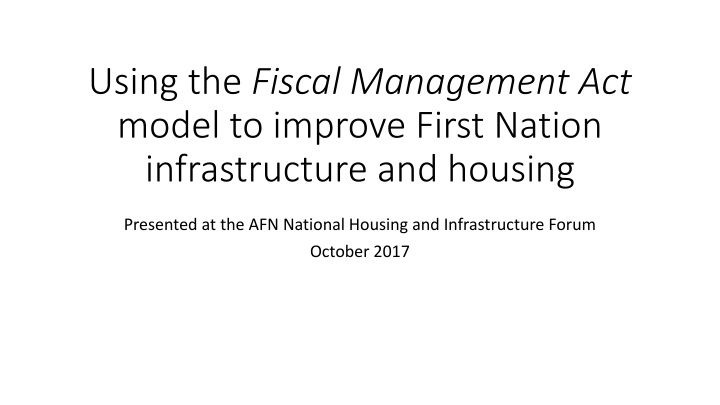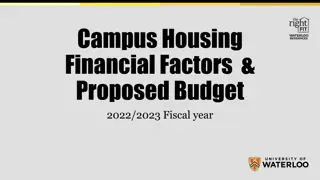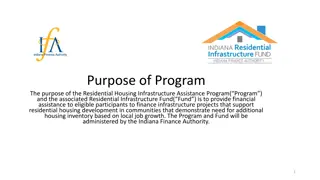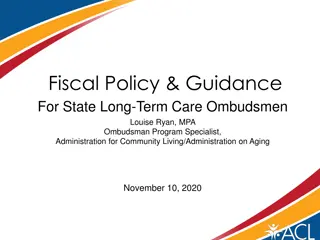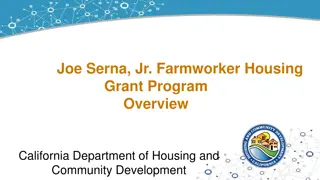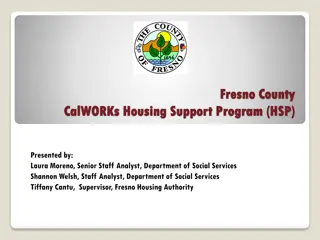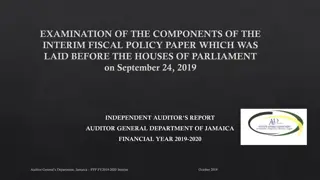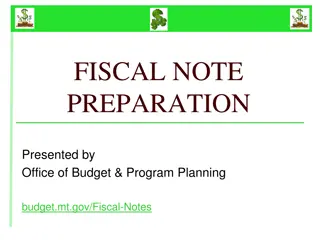Improving First Nation Infrastructure and Housing through Fiscal Management Act Model
The presentation at the AFN National Housing and Infrastructure Forum in October 2017 highlighted the challenges faced by First Nation communities in developing sustainable infrastructure. The current system is inefficient, prompting the exploration of alternatives like the First Nations Fiscal Management Act model. By addressing the root causes such as lack of jurisdiction and stable revenues, this model aims to close the infrastructure gap and enhance infrastructure sustainability. The model involves creating a First Nation Infrastructure Institution under the FMA framework to empower First Nations in infrastructure development and maintenance.
Download Presentation

Please find below an Image/Link to download the presentation.
The content on the website is provided AS IS for your information and personal use only. It may not be sold, licensed, or shared on other websites without obtaining consent from the author.If you encounter any issues during the download, it is possible that the publisher has removed the file from their server.
You are allowed to download the files provided on this website for personal or commercial use, subject to the condition that they are used lawfully. All files are the property of their respective owners.
The content on the website is provided AS IS for your information and personal use only. It may not be sold, licensed, or shared on other websites without obtaining consent from the author.
E N D
Presentation Transcript
Using the Fiscal Management Act model to improve First Nation infrastructure and housing Presented at the AFN National Housing and Infrastructure Forum October 2017
State of First Nation Infrastructure First Nation infrastructure takes longer to develop First Nation infrastructure costs more to build First Nation infrastructure does not last as long as other infrastructure in other communities in the rest of Canada The current infrastructure system is ineffective and the federal government has signaled its commitment to seek alternatives to INAC support of infrastructure and other services
Root causes Most First Nation governments don t exercise jurisdiction over the planning, operation, maintenance and replacement of their infrastructure like other governments Most First Nations don t have the necessary fiscal powers and stable revenues to fiscally sustain infrastructure Without jurisdiction and stable revenues, all elements of the infrastructure cycle (planning, design, financing, construction, operation, maintenance and replacement) take longer and cost more Gaps in regulations, standards, planning, financing, and administration leads to less sustainable infrastructure systems
An option to close the gap using the First Nations Fiscal Management Act model 230 First Nations have chosen to use the tools of the FMA It closes many infrastructure financing gaps It protects First Nation jurisdiction FMA institutions and proponents are proposing the creation of a First Nation Infrastructure Institution as an additional FMA institution to implement and protect infrastructure jurisdiction for interested First Nations
Build on successful framework used by FMA institutions: 1. Guided, directed and controlled by First Nations 2. Optional and respect the right to self-determination 3. National institution with offices across Canada 4. An FMA institution a) FMB will provide certification to participating First Nations to access secure long term infrastructure transfer funding b) FNTC will work with participating First Nations to expand their fiscal powers and grow their revenue bases c) FNFA will provide access to long term infrastructure financing 5. Focus on implementing infrastructure jurisdiction and supporting infrastructure and housing projects 6. Work with and support existing First Nation infrastructure institutions and other possible partners
Proposed purposes Assist interested indigenous governments in their transition to more environmentally, economically and fiscally sustainable infrastructure Support interested indigenous governments in the exercise of their jurisdiction over infrastructure development on their lands Work with participating First Nations and the federal government to deliver secure, stable, long term infrastructure transfers for participating indigenous governments Develop formulas and processes for effective and efficient infrastructure funding Support long term infrastructure financing through the FNFA for participating First Nations
Proposed purposes (continued) Help transition ownership of infrastructure to interested indigenous communities Support aggregations of indigenous communities as part of nation groupings or to achieve economies of scale Promote understanding of the infrastructure development process and the linkage with economic and fiscal sustainability Provide support for implementation of standards and laws required to support infrastructure projects Assess infrastructure project readinesss and support infrastructure planning Develop training programs and build capacity and administrative efficiencies in participating indigenous governments for infrastructure construction, management and finance
Proposed purposes (continued) Support more integrated infrastructure planning (environmental, economic, capital, land and financing) for indigenous governments Work with the other fiscal institutions to build the necessary legal and administrative frameworks and systems that support improvements to planning, design, financing, construction, maintenance and operation, and replacement of indigenous infrastructure Advocate for new FMA revenue streams within an improved fiscal framework to build fiscally sustainable indigenous infrastructure Assess infrastructure risks and develop risk management strategies including public private partnerships Achieve administrative efficiencies in the provision of services, procurement and funding to participating indigenous governments
First Nation Infrastructure Institution (FNII) First Nation led Optional National Sustainable infrastructure Build on strengths of the FMA
